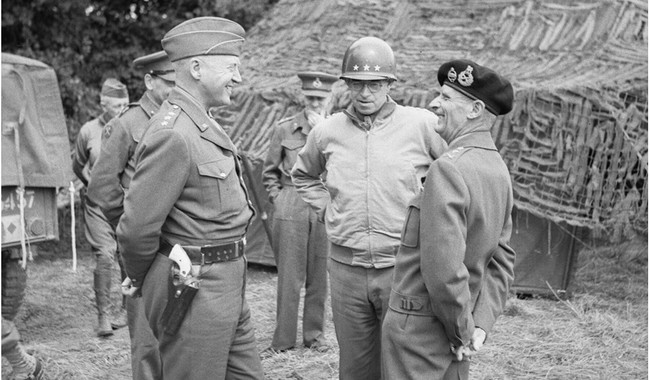The Man: General George Smith Patton
General George Patton Jr. was a singular man. Driven, determined, and profane, with standards that were almost impossibly high, he was the best-attacking general in the Allied forces in World War 2. He took on Erwin Rommel and whipped him, reportedly after having read Rommel’s 1936 book “Infantry Attacks.” Sadly, there is no evidence that Patton ever made his famous shout across the battlefield portrayed by George C. Scott in the film “Patton”: “Rommel, you magnificent b*****d, I read your book!”
For all his flaws and foibles, George Patton was a man who commanded respect, and he has been one of my personal heroes for many years. My favorite sixgun, in fact - the Smith & Wesson N-frame 25-5 that I generally carry wood-bumming - has ivory grips with my initials inlaid into them because, as we all know, if Patton did it, it must be cool.
Indeed, it is the man’s sidearms that I wish to write about, for they were as distinctive as the general.
The italicized items at the beginning of each section are verified quotes from General Patton himself. Now, for the man’s sidearms.
The Single Action Army
There are four hundred neatly marked graves somewhere in Sicily. All because one man went to sleep on the job. But they are German graves because we caught the b*****d asleep before they did.
Patton began his Army career by accompanying General John “Blackjack” Pershing into Mexico to pursue and punish the bandit Pancho Villa. In one altercation, the young Lieutenant Patton was shot at while leading a supply caravan. When the Americas returned fire, the Mexicans turned to flee, but Patton wasn’t having it. He emptied his sidearm, the great Colt Single Action Army, three times. That close-range firefight convinced Patton of the need for two revolvers, although he later gave away one of the Colts to an unnamed Hollywood actor he admired – and I’m certain there’s an interesting story indeed behind that.
It is the ivory-handled Colt that Patton is best known for, and in most photos of the man where he can be seen to be wearing a sidearm, it’s usually the Colt.
 But in the 1930s, something new came along in the world of revolvers, and George Patton was quick to adopt the new cartridge: The .357 Magnum.
But in the 1930s, something new came along in the world of revolvers, and George Patton was quick to adopt the new cartridge: The .357 Magnum.
The Smith & Wesson Registered Magnum
My men don't dig foxholes. I don't want them to. Foxholes only slow up an offensive. Keep moving. And don't give the enemy time to dig one either. We'll win this war, but we'll win it only by fighting and by showing the Germans that we've got more guts than they have; or ever will have.
The first revolver Smith & Wesson built for the new cartridge was the big, beefy N-frame Registered Magnum. Patton had one delivered to Hawaii in 1935, where he was stationed, and quickly became fond of the gun and its new, powerful cartridge. While he never again entered into a face-to-face gunfight with a sidearm, he referred to the big Smith as his “killing gun.” As was his habit, he removed the gun’s original walnut grips and replaced them with ivory. When a reporter once mistakenly referred to the gun as having pearl grips, Patton reportedly barked that “…only a New Orleans pimp would carry a pearl-handled revolver.”
And, yes, his Registered Magnum, along with his Colts, are the model for my own N-frame 25-5 Smith, right down to the ivory grips with my initials inlaid.
See Related: 98-Year-Old WWII Vet Brings the House Down at RNC: If Trump Were President, I Would 'Re-Enlist Today'
Great Moments in Military History: The B-17 Flying Fortress
The Remington Model 51
Few men are killed by bayonets, but many are scared by them. Having the bayonet fixed makes our men want to close. Only the threat to close will defeat a determined enemy.
Patton was known to carry the small, easily concealed Remington in .380ACP (9mm Browning Short) caliber. It was with this pistol that he famously stood in the middle of a street outside his North Africa headquarters firing the Remington at German bombers who were conducting a raid. He maintained later that he had shot one of the bombers down, although that seems unlikely.
Others rumored:
Wars may be fought with weapons, but they are won by men. It is the spirit of the men who follow and of the man who leads that gains the victory.
Patton was rumored to carry two other sidearms at times, but I was not able to find a photo or any confirmation of either.
The Colt 03 Pocket Model
Every man is scared in his first battle. If he says he's not, he's a liar. Some men are cowards but they fight the same as the brave men or they get the hell slammed out of them watching men fight who are just as scared as they are. The real hero is the man who fights even though he is scared.
The Colt Pocket Model is a slick little thing, normally found in .32 ACP, which is a bit of a pipsqueak, especially with the ammo available at the time. But it has a great advantage: It's easy to carry, concealed and unobtrusive, and if it's not powerful, it would be a nasty surprise at close quarters nonetheless. And in an emergency, any gun is better than no gun.
The Smith & Wesson Chief’s Special
My flanks are something for the enemy to worry about, not me. Before he finds out where my flanks are, I'll be cutting the b*****d's throat.
Again, I have not been able to confirm this one, although the short, handy .38 Special revolver may well have appealed to the general.
All of these handguns I have been able to find photos of, save the Remington, were customized with ivory grips with Patton’s initials inlaid in them. The Registered Magnum appears to be fitted with target sights and a 3.5” barrel, making for a fast, accurate sidearm. The Colt Single Action Army retains its fixed sights but is heavily engraved.
In conclusion:
George S. Patton was a man in the profession of arms, and he took that very seriously. In his later years, he only carried a sidearm or two, but he was rarely seen without one. Military leaders today would do well to emulate him. We have, in recent years, had several criminal shootings on military bases. I’ve been saying for some years now that our service men and women are in the profession of arms and so should be, you know, armed. Officers and NCOs should be issued a sidearm and holster as part of the uniform and should be required to be armed while on duty. If we cannot trust a service member with a sidearm, we cannot trust them to protect the liberty and property of the citizens, and they should be discharged.
The general was also a man who appreciated the value of style and flamboyance. He was a soldier’s general, referred to as “Old Blood and Guts,” even if that did prompt some soldiers less impressed with the general’s aggression to say, “Our blood, his guts.” But flamboyant, profane, and inflexible as he was, he beat Rommel, he beat everything the German Army and the SS could throw at him, and he won.
You can’t ask more of a wartime general than that.
Patton was a man of his time, and we cannot completely judge him by the standards of our own, but we can admire the grit of the man – and his taste in sidearms, which I will say, was excellent.














